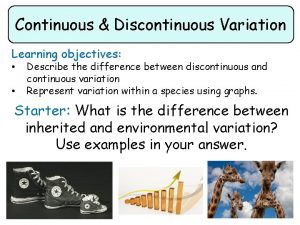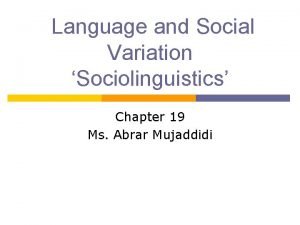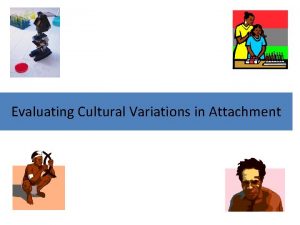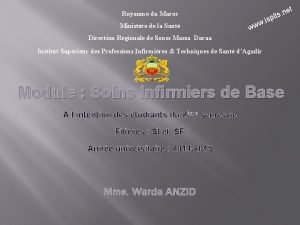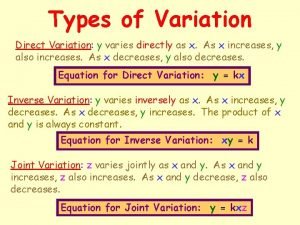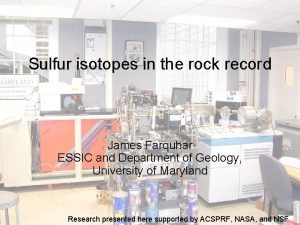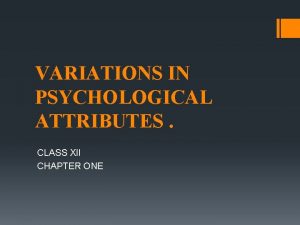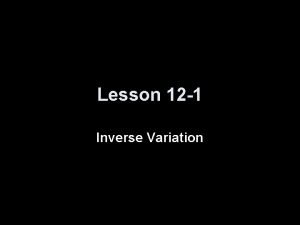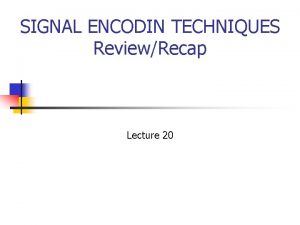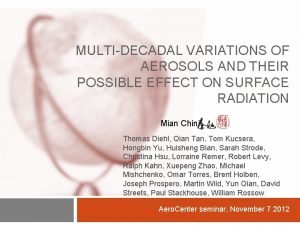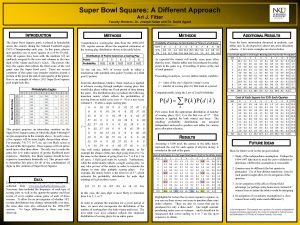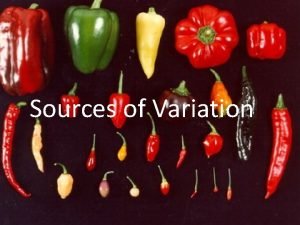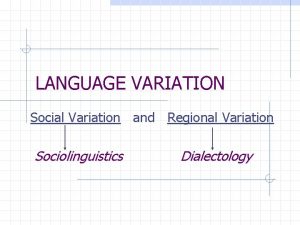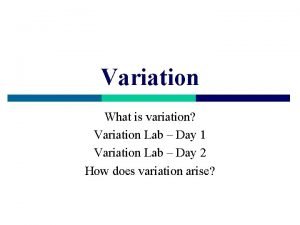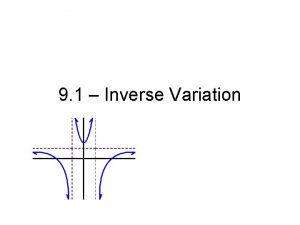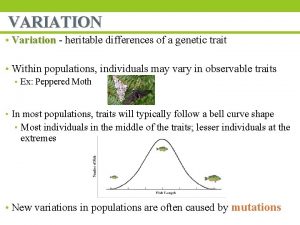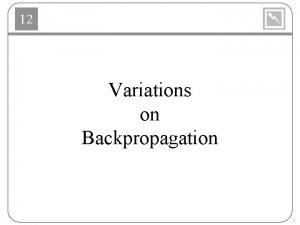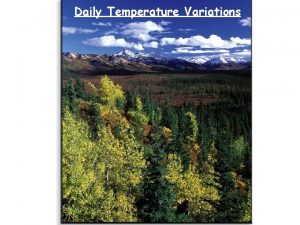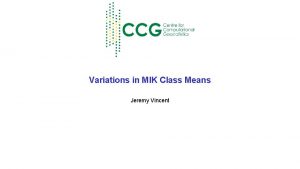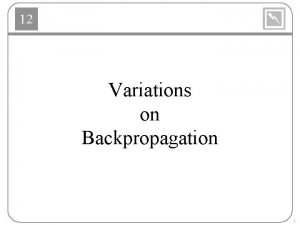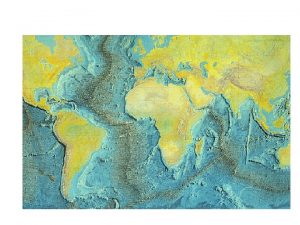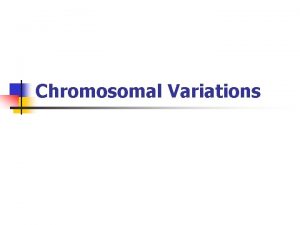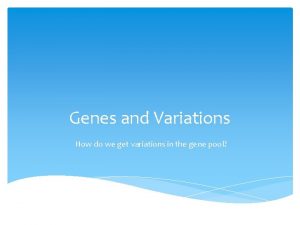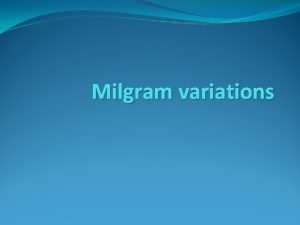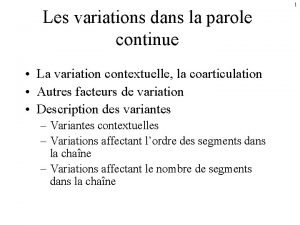Variations Variations Variation is the range of differences
















































- Slides: 48

Variations

Variations Variation is the range of differences that there are between individual organisms of same species.

Variation can be within species (Think of all the differences between individual humans) These are different varieties of the same species

Or between species: Gorilla Proboscis monkey

v Mendel described how heredity factors(i. e. genes) determine the genotype of an organism. which in the course of evolution become expressed in the structural, functional characteristics of phenotype. All these features v show normal distribution (see graph)

distri TYPES OF VARIATIONS Germinal Indeterminate Somatic Discontinuous Determinate Continuous

Germinal / Blastogenic Variations q Arise in the germ cells of an organism. q Due to recombination, Mutation. q Germinal variations are heritable. q They are intrinsic i. e. originate inside the body. q Not affected by any external influence of environment. q Ex. Occasional occurrence of supplementary digits (polydactyl), in humans, horse, cats etc.

Somatic / acquired Variations q Somatic variations are extrinsic. q Occur due to the influence of environmental on the organism. q They affect & are acquired in the life time of the individual. q Environmental factors such as food, temperature, climate etc. These plants are genetically identical, the flower colour difference is due to the effects of soil p. H.

Determinate / orthogenic Variations q When changes occur in a definite direction & with a definite pattern. q Ex. Overgrown antlers in Irish deers.

Indeterminate Variations q When changes occur without any definite pattern & in a different directions. q These provide raw material for Darwin’s natural selection.

Discontinuous/ Qualitative Variations § Showing clear-cut variations. § Show a limited form of variation. § Ex. Blood groups in humans, wing length in Drosophilia, Coat colour in Rabbit, Sex in animals (Male & female). § Controlled by two major genes. § Phenotypic expression is unaffected by environmental factors.

Continuous/ Quantitative Variations § Many characteristics (quantitative phenotypic traits). § Show complete change without any break. § Produced by combined effect of many genes & also environmental factors. § Individually each gene has a litthe effect but collectively they are significant. § Ex. Shape & colour of organs, colour of wheat, Skin colour of humans.

Sources of Variations 1 2 REPRODUCTION MUTATION Causes of Variations Ø Chromosomal ü Heat ü Cold ü Enemies ü Scarcity of food ü Other external conditions ü Amphimixis Ø Gene

TH AN KS !!!


Variation and Evolution Many of the differences between species are present because they help the individuals to survive. We call these differences ADAPTATIONS. You should understand that there are Adaptations to: ANATOMY or body FORM, PHYSIOLOGY or body FUNCTION BEHAVIOUR

Variation and Evolution SAGUARO CACTUS Accordion folded stem is fleshy to store water Roots mostly less than 15 cm deep but cover huge area 1 deep tap root Can absorb 750 litres water in a single storm Leaves reduced to spines to reduce transpiration rate Waxy cuticle reduces transpiration Stomata only open at night

Variation and Evolution Adaptations of Marram Grass, a xerophyte Rolled leaf Thick cuticle Sunken stomata Epidermal hairs What is the purpose of these adaptations? Explain how they work using AS vocabulary Make notes on the diagram provided

Variation and Evolution Outline the behavioural, physiological and anatomical (structural) adaptations of organisms to their environments You should be able to suggest several different types of adaptations of organisms that help them to survive. Make note of some examples from the “Journey of Life” DVD Choose one example from the DVD and research further

Variation and Evolution Explain the consequences of the four observations made by Darwin in proposing his theory of natural selection. What are the 4 observations that Darwin made? 1. Offspring generally appear similar to parents. 2. No two individuals are identical. (Why not? ) 3. organisms have the ability to produce large numbers of offspring 4. Populations in nature tend to remain fairly stable in size. SO what are the consequences?

Variation and Evolution Because individuals over produce, yet populations remain stable COMPETITION must take place. In COMPETITION there are “winners” and “losers”. Winners are better adapted with more useful characteristics, they are more able to survive and breed, so pass on their beneficial alleles. Over time when this happens continually, accumulated changes can give rise to a new species.

Variation and Evolution Outline how variation, adaptation and selection are major components of evolution. Differences in organisms How do they arise? Where do these changes happen? How can they be passed on?

Natural Selection Variation in organisms characteristics are caused by the organisms having different alleles of genes. Some differences enable the organism to survive better (compete more successfully) The ones with beneficial alleles survive, breed and pass on their alleles to the next generation Those without beneficial alleles die before they reproduce, so their alleles are less likely to be passed on. The beneficial alleles increase in frequency in the population and may eventually produce a new species.

Selection Pressures Competition for food, water, minerals Predation, grazing Disease Physical and chemical factors Competition for mates Competition for space, nesting sites, territory etc An allele that helps an organism compete better is “selected for”, increases in frequency An allele that fails to help an organism survive is usually “selected against”, decreases in frequency

The sequence described is termed NATURAL SELECTION Darwin proposed that Natural Selection could lead to new species being produced over time. This was his explanation for the large number of different species of finch found in the Galapagos Islands. Each species has adaptations to its body, beak and feet that allow it to feed on specific types of food in specific areas.

Darwin’s Finches

Evolution of a new species “Speciation” Speciation occurs when there is a “Reproductive Barrier”, some thing that stops members of an original population passing their alleles freely among all members The barrier may be a geographical barrier = ALLOPATRIC speciation The barrier may be behavioural, biochemical, or anatomical =SYMPATRIC speciation

Allopatric speciation One large interbreeding population exists at the start of the process Two isolated populations are created by the formation of a barrier - in this case, rising sea level. Subsequent to their separation, the two populations diverge in response to differing selective pressures. At this point, the two populations are proto-species. They may diverge even further and become unable to interbreed at all.

Sympatric Speciation When there is NO geographical barrier Initially individuals in the original species may have variations that can be divisive of the population. Eg in birds some might have slightly: different shaped beaks shorter wings, better nocturnal vision, different colour plumage or courting behaviour, etc

Speciation in the Genus CANIS

Evidence for Evolution Fossil record- simplest organisms in oldest rocks, old species extinct, new species develop. Reptile/bird link, horse evolution, human evolution. Biochemical- Similar biochemistry of all living things, closely related species have similar biochemistry, the longer ago they diverged the more different the biochemistry. Amino acid sequences in cytochrome c (used in respiration). Species with same amino acid sequences are closely related, the bigger the differences the less closely related they are and the further back they diverged DNA and RNA polymerase are made of basic polypeptide chains in all organisms but higher organisms have extra sub units to help regulation of DNA and RNA production. Similar sub units can indicate closely related species DNA differences are greater between species which are not closely related

Evidence for Evolution

Evolution and growth of Human Brain

Cytochrome C differences The larger the number of differences between the 2 groups the further back in time they diverged.

Shared DNA Humans have about 95% of their DNA in common with Chimpanzees Humans have about 75% of their DNA the same as Fruit Flies

Using the Evidence for Evolution This evidence can be used to support decisions made about classification. Phylogeny is the study of evolutionary relationships between organisms (p 201) Decisions are made using the criteria from the previous slide and other tests Natural Classification groups organisms according to how closely related they are; this should match the evolutionary tree produced by considering how recently organisms shared a common ancestor.

DISCUSS WHY THE EVOLUTION OF PESTICIDE RESISTANCE IN INSECTS AND OF DRUG RESISTANCE IN MICROORGANISMS HAS IMPLICATIONS FOR HUMANS. © Pearson Education Ltd 2008 This document may have been altered from the original

Resistance to antibiotics or pesticides Variation amongst individuals (caused by mutations to genes) in a population means some are better adapted to survive the presence of these chemicals than others The individuals able to survive in the presence of antibiotic or pesticide have beneficial alleles. Those without the beneficial alleles die and do not reproduce Those with the beneficial alleles reproduce and pass on their alleles to the next generation Resistance in the population increases The frequency of the alleles in the population changes

Mechanisms of Resistance Enzymes may break down the antibiotic/ pesticide/ toxin Receptors for pesticide/ antibiotic/ toxin may be altered so binding no longer occurs Membrane or body is less permeable to antibiotic/ pesticide/ toxin Excretion rate of antibiotic/ pesticide/ toxin increases and keeps levels in cells too low to have an effect.

F 212 Jan 2010 Q 3 parts c, d, e

Classification 1 Old system-”Plants” and “Animals” Plants included anything that wasn’t an animal! Not just photosynthetic organisms but also fungi and bacteria Developments in microscopy and other techniques showed big differences in the structure and biochemistry of many organisms in the “plant” group that prompted changes to the classification system

Classification 2 In 1969 Robert Whittaker proposed that living organisms should be divided into 5 “Kingdoms” Prokaryotes/ Monera Protoctista Fungi Plants Animals Look at important features of each kingdom and LEARN! Page 202 -203

Classification 2 Make a table to include the following features of each kingdom: Nucleus Cell walls Organelles and microtubules Type of nutrition Motility (ability to move themselves) Nervous co-ordination Give an example of an organism from each kingdom

Features Kingdoms Prokaryote Nucleus Cell wall Organelle + microtubule Type of nutrition Motility Nerves coordination Examples Protoctista Fungi Plants Animals

Features Kingdoms Prokaryote Protoctista Fungi Plants Animals Nucleus no yes Yes yes Cell wall Yes, made of peptidoglycan Sometimes present Yes, made of chitin Yes, made of cellulose no Organelle + microtubule no yes yes Type of nutrition Autotrophic or heterotrophic Heterotrophic Autotrophic Heterotrophic Motility Some have flagella Some have undulipodia or cilia no no Yes, muscular tissue Nerves coordination no no yes Examples Bacteria and cyanobacteria Algae, slime moulds, paramecium Mould fungi, yeast Liverworts, mosses, ferns, conifers, flowering plants Jellyfish, corals, worms, insects, vertebrates

Classification 2 Divisions of the Kingdoms into “taxa” (classification groups/levels). See pages 204 -205 Kingdom Phyla Class Order Family Genus Species Make up a mnemonic for KPCOFGS The Genus and species give us the binomial Latin names of organisms Eg Homo erectus, Pongo pygmaeus

Outline the binomial system Use a dichotomous key See pages 206 -207

Classification 3 As more and more information has become available scientists have considered reorganising classification into 3 “Domains” which are then divided further 1990 Carl Woese suggested the following domains Bacteria (Eubacteria-true bacteria) Archae (Archaebacteria) Eukaryote
 Constant of variation
Constant of variation Direct and inverse variation graphs
Direct and inverse variation graphs Prediction interval formula
Prediction interval formula Differences between continuous and discontinuous variation
Differences between continuous and discontinuous variation Social variation in sociolinguistics
Social variation in sociolinguistics As compared to long-range forecasts, short-range forecasts
As compared to long-range forecasts, short-range forecasts Variations
Variations Cultural variations in attachment
Cultural variations in attachment Possible variations
Possible variations Variations pathologiques de la température
Variations pathologiques de la température Varies jointly example
Varies jointly example Snow white 1812
Snow white 1812 Varies directly
Varies directly Possible variations
Possible variations Computer organization & architecture: themes and variations
Computer organization & architecture: themes and variations Linked list variations
Linked list variations Variations in psychological attributes
Variations in psychological attributes Productive service capacity
Productive service capacity Equation for inverse variation
Equation for inverse variation Natural variations operations management
Natural variations operations management Possible variations
Possible variations Stability factor for emitter bias
Stability factor for emitter bias Is a direct variation a linear function
Is a direct variation a linear function Sin rule for sides
Sin rule for sides Variations
Variations Kwhl chart
Kwhl chart Language variation definition
Language variation definition Super bowl squares variations
Super bowl squares variations Youtube-com
Youtube-com Valuation of variations
Valuation of variations Variations de stock
Variations de stock Hổ sinh sản vào mùa nào
Hổ sinh sản vào mùa nào Slidetodoc
Slidetodoc đại từ thay thế
đại từ thay thế Diễn thế sinh thái là
Diễn thế sinh thái là Vẽ hình chiếu vuông góc của vật thể sau
Vẽ hình chiếu vuông góc của vật thể sau Mật thư tọa độ 5x5
Mật thư tọa độ 5x5 Thế nào là mạng điện lắp đặt kiểu nổi
Thế nào là mạng điện lắp đặt kiểu nổi Chụp phim tư thế worms-breton
Chụp phim tư thế worms-breton Lời thề hippocrates
Lời thề hippocrates Vẽ hình chiếu đứng bằng cạnh của vật thể
Vẽ hình chiếu đứng bằng cạnh của vật thể Quá trình desamine hóa có thể tạo ra
Quá trình desamine hóa có thể tạo ra Các châu lục và đại dương trên thế giới
Các châu lục và đại dương trên thế giới Bổ thể
Bổ thể Sự nuôi và dạy con của hươu
Sự nuôi và dạy con của hươu điện thế nghỉ
điện thế nghỉ Dạng đột biến một nhiễm là
Dạng đột biến một nhiễm là Biện pháp chống mỏi cơ
Biện pháp chống mỏi cơ Phản ứng thế ankan
Phản ứng thế ankan



